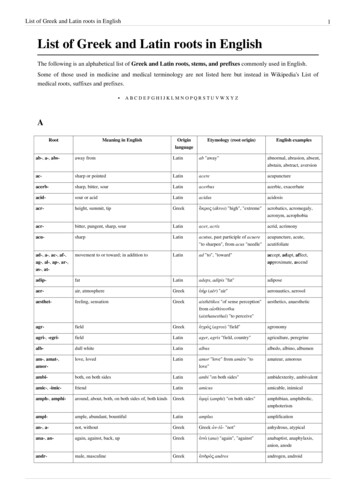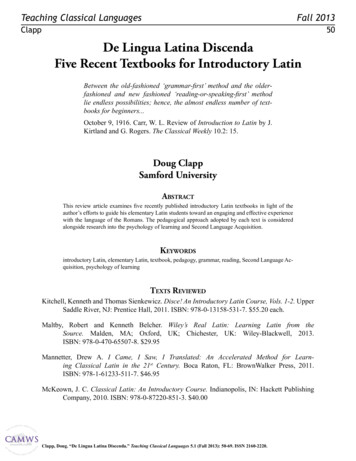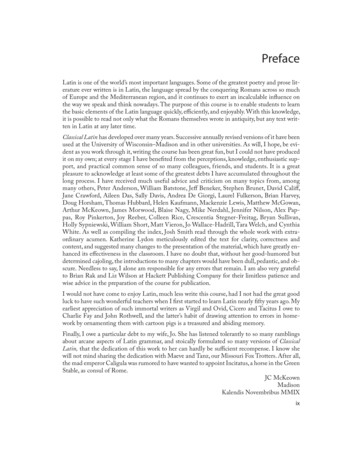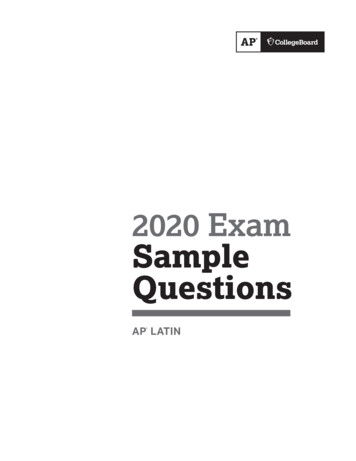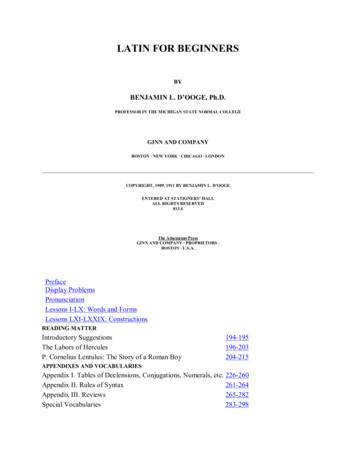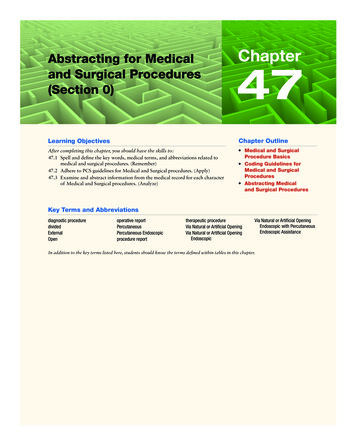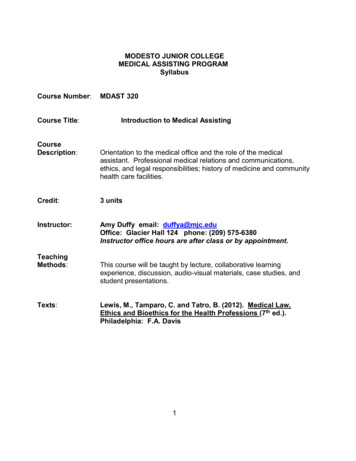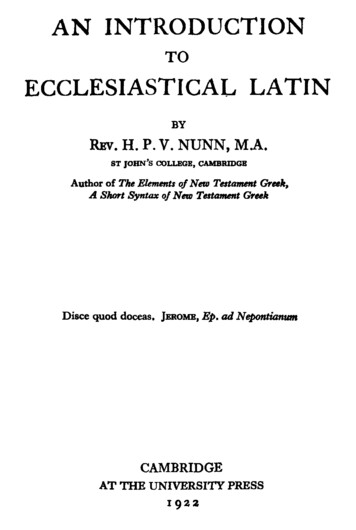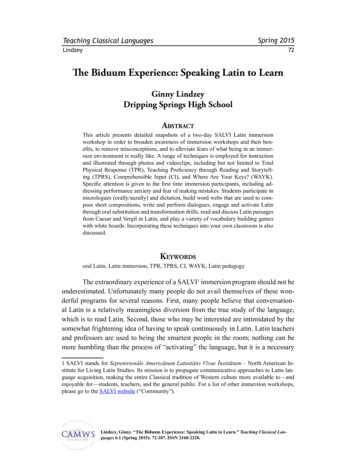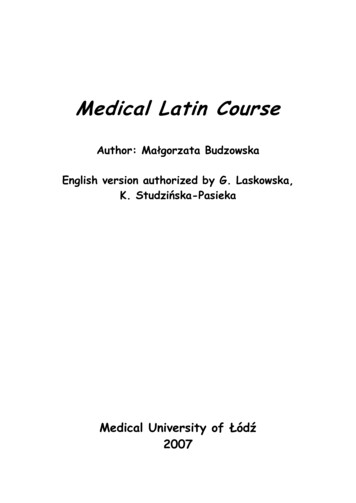
Transcription
Medical Latin CourseAuthor: Małgorzata BudzowskaEnglish version authorized by G. Laskowska,K. Studzińska-PasiekaMedical University of Łódź2007
Class 1I. Pronunciation in LatinVowelsLatin VowelaeiouyPronunciationa (father)e (pet)ee (need)o (drop)oo (soon)y (youth)Remember: A few vowel combinations, called diphthongs, are read as one letter.Latin DiphthongPronunciationae*aueieuoee (red)ow (how)ey (they)eu (leucocyte)e (red)* If over the e in diphthong ae or oe there are, so called, puncta diaeresis – points of separate, eg. word aër (air), weread letters separately.Remember: Most Latin consonants have the same sounds as in English but with theexceptions listed below.ConsonantsLatin ConsonantcgjrsvxzbsbtccchPronunciationsi (before e, i, y, ae, oe) (cinema)k (before a, o, u, before consonants, in the end of a word)(computer)g (good; never as in ginger)y (young)r (grill)s (softly)v (vinegar)ks (tax)dz (adze)bs (obsession)bt (obtuse)kk (book-keeping)ch (character; never as in chapel)
nguphthrhtiqungv (before vowel) (linguistics)ngju (before consonant) (angular)ph (microphone)t (turn)r (grill)ti (patio; never as in motion)kv (quota)Exercise 1Please read the following words correctly:1 cancer, medicamentum, auris, abortus, articulatio, lingua2 ventriculus, res, oculus, sanguis, pectus, thorax3 corpus, dens, fel, epiphysis, caries, oesophagus4 hemispherium, ichthyismus, thrombus, scarlatina, angulus, olfactus5 intestinum, incisura, rhinitis, series, aqua, pharmacon6 oedema, musculus, vena, cytoplasma, defectus, dolor7 rabies,sutura, causa, medicus, cellula, os8 curatio, visus, homo, lapis, cutis, abductor9 diaphysis, processus, sulcus, scabies, epicondylus, fascia10 punctum, insertio, ictus, cranium, epithelium, cavum11 encephalon, colon, metacarpus, bacterium, plexus, vitium12 rubeola, exophthalmia, diphtheria, migraena, costa, tactusII. Glossary of Latin grammatical termsLatin Nouns* Latin nouns have gender: they’re masculinum (masculine), femininum (feminine), or neutrum(neuter). Each of gender has own suffix attached to the word.* Latin nouns have five basic cases that determine what function the noun serves in the sentence.The word’s suffix determines the noun’s case.* Latin has five declensions (noun groups that use the same suffix for each case).* Latin nouns are declined in two numerals: singularis (singular) and pluralis (plural).Declining Nouns* A noun can have a wider range of uses just by changing its suffix (or the letters attached to the endof the word). What follows are the most commonly used cases:
Nominativus (Nominative): indicates SubjectRemember: Latin doesn’t have articles (such a, an, the), so when you translate asentence from Latin to English, you’ll have to add those yourself.Genetivus (Genitive): indicates PossesionRemember: When you translate Genetive into English, use of before nounDativus (Dative): indicates Indirect objectAccussativus (Accusative): indicates Direct objectAblativus (Ablative): Expresses how sth happens – by, with or from* Vocativus (Vocative): Used only in adressing or calling someone.Declension is a group of nouns that form their cases the same way – that is, use the samesuffix. Every noun has two basic forms: Nominativus and Genetivus (always in this order),that have to be presented in dictionary. In what declension a noun is declined we recognizeby the suffix of Genetivus:1st decl.Genetivus:- ae2nd decl. 3rd decl. 4th decl. 5th decl.-i- is- us- eiExercise 2Please read and determine a declension of the following nouns (presented in two basic forms):1 cancer, cancri; medicamentum, medicamenti; auris, auris; abortus, abortus; articulatio,articulationis; lingua, linguae;2 ventriculus, ventriculi; res, rei; oculus, oculi; sanguis, sanguinis; pectus, pectoris; thorax,thoracis;3 corpus, corporis; dens, dentis; fel, fellis; epiphysis, epiphysis; caries, cariei; oesophagus,oesophagi;4 hemispherium, hemispherii; ichthyismus, ichtyismi; thrombus, thrombi; scarlatina, scarlatinae;angulus, anguli; olfactus, olfactus;5 intestinum, intestini; incisura, incisurae; rhinitis, rhinitidis; series, seriei; aqua, aquae;pharmacon, pharmaci;
6 oedema, oedematis; musculus, musculi; vena, venae; cytoplasma, cytoplasmatis; defectus,defectus; dolor, doloris;7 rabies, rabiei; sutura, suturae; causa, causae; medicus, medici; cellula, cellulae; os, ossis;8 curatio, curationis; visus, visus; homo, hominis; lapis, lapidis; cutis, cutis; abductor, abductoris;9 diaphysis, diaphysis; processus, processus; sulcus, sulci; scabies, scabiei; epicondylus, epicondyli;fascia, fasciae;10 punctum, puncti; insertio, insertionis; ictus, ictus; cranium, cranii; epithelium, epithelii; cavum,cavii;11 encephalon, encephali; colon, coli; metacarpus, metacarpi; bacterium, bacterii; vitium, vitii;plexus, plexus;12 rubeola, rubeolae; exophthalmia, exophthalmiae; diphtheria, diphtheriae; migraena, migraenae;tactus, tactus; costa, costae.Class 2I. The meaning of Latin Cases.SingularisNominativus Who/What is doing? – The friend is reading a book.GenetivusWhose is it? (this case shows the owner) – This is the friend’s book.DativusFor whom is it? – This is a book for the friend.AccussativusWho/What (for example - are you/is he/are they etc. watching?) - I’mwatching the friend.AblativusWith/by whom (for example - are you/is he/are they etc. read?) – A bookis read by the friend.VocativusCalling someone – Oh, friend, let’s go!PluralisNominativusFriends are reading a book.GenetivusThis is friends’ bookDativusThis book is for friends.AccussativusI’m watching friends.AblativusA book is read by friends.Vocativus*Oh, friends, let’s go!
Vocativus is not used in medical Latin.II. Declension.In English we use prepositions or we change the word order to express the meaning of noun.In Latin we attach the suffix to the end of the word instead. Declension consists in changingthe suffix in every case.III. First declension.In the first declension we decline nouns, that are of femininum (feminine gender) and havethe suffix – a in Nominativus, and the suffix – ae in Genetivus.Noun of femininum: Nom. – a, Gen. – ae1. In dictionaries we can find following information concerning noun: its two basic forms (Nom.,Gen.) and its gender. For example:amica, amicae (f.) – girlfriend2. From the suffix of the second basic form (Gen.) we recognize that it is the noun of the firstdeclension (see: the table on page 4).3. And now we can start decline this noun:SingularisNom. amic – aGen. amic – ae(a girlfriend)(girlfriend’s)(and now we have to cut off this characteristic suffix of Genetivus and thenwe have stem of noun, that is the base for other forms of cases)Dat.Acc.Abl.amic – aeamic – amamic – a(for a girlfriend)([you are watching] a girlfriend)(by/with a girlfriend)amic – aeamic – arumamic – isamic – asamic – is(girlfriends)(girlfriends’)(for girlfriends)([you are watching] girlfriends)(by/with girlfriends)PluralisNom.Gen.Dat.Acc.Abl.
Exercise 1Please read the following nouns and determine their declension. If you find the noun of the firstdeclension, please decline it.1 tetanus, tetani; gangrena, gangrenae; collum, colli; pulsus, pulsus; contusio, contusionis.2 atrium, atrii; derma, dermatis; neonatus, neonati; exitus, exitus; tibia, tibiae.3 icterus, icteri; functio, functionis; orbita, orbitae; sternum, sterni; partus, partus.4 serum, seri; vertebra, vertebrae; gradus, gradus; botulismus, botulismi; operatio, operationis.5 signum, signi; fractura, fracturae; pulmo, pulmonis; status, status; bronchus, bronchi.6 coxa, coxae; nervus, nervi; duodenum, duodeni; cortex, corticis; fetus, fetus.7 digitus, digiti; spatium, spatii; infarctus, infarctus; haemorrhagia, haemorrhagiae; ren, renis.8 septum, septi; lapara, laparae; spasmus, spasmi; larynx, laryngis; usus, usus.IV. Nouns of the 1st declension, which derive from the Greeklanguage.In the first declension are also declined nouns, which derive from the Greek language, thathave the feminine gender and in Nominativus have the suffix – e and in Genetivus have thesuffix – es.Nouns of femininum derive from the Greek language: Nom. – eGen. – esAnd also in the first declension are declined nouns, which derive from the Greek language,that have the masculine gender and in Nominativus have the suffix – es and in Genetivus havethe suffix – ae.Nouns of masculinum derive from the Greek language: Nom. – esGen. – aeDeclension of the nouns, which derive from Greek:1. Group of the nouns of feminine gender: raphe, raphes (f.) – sutureSingularisNom.Gen.Dat.Acc.Abl.raph – eraph – esraph – aeraph – enraph – e/aPluralisraph – aeraph – arumraph – israph – asraph – isExamples of these nouns:chole, choles – bilesystole, systoles – contraction of heartphlegmone, phlegmones – phlegmon (inflammation of connective tissue, leading to ulceration)
haemoptoë, haemoptoës – bloody sputumacne, acnes – acnesyncope, syncopes – faintingdiastole, diastoles – diastole (decontraction of heart)gonorrhoë, gonorrhoës – gonorrhoe, clap (a sexually transmitted disease, caused by the bacteriumNeisseria gonorrhoeae, that affects the genital mucous membranes of either sex)diarrhoë, diarrhoës – diarrhoea2. Group of the nouns of masculine gender: diabetes, diabetae (m.) – diabetesSingularisNom.Gen.Dat.Acc.Abl.Pluralis – in this group of nouns pluralisdoesn’t existdiabet – esdiabet – aediabet – aediabet – endiabet – a/eIn medical Latin we also have one more example of such nouns: ascites, ascitae –hydroperitoneum.PATHOLOGICAL STATES(nouns of the first declension)allergia, allergiae – allergy: a disorder in which the body becomes hypersensitive to particularantigensanaemia, anaemiae – anaemia, oligocytosis: a reduction in the quantity of the oxygen – carryingpigment haemoglobin in the bloodangina, anginae – angina: a sense of suffocation or suffocating painataxia, ataxiae – ataxia: the shaky movements and unsteady gait that result from the brain’s failureto regulate the body’s posture and the strength and direction of limb movementsatrophia, atrophiae – atrophy, wasting: the wasting away of a normally developed organ or tissuedue to degeneration of cellscataracta, cataractae – cataract: any opacity in the lens of the eye, resulting in blurred visioncolica, colicae – colic: severe abdominal pain, usually of fluctuating severity, with waves of painseconds or a few minutes apartdiphtheria, diphtheriae – diphtheria: an acute highly contagious infection, caused by thebacterium Corynebacterium diphtheriae, generally affecting the throat but occasionally othermucous membranes and the skindysenteria, dysenteriae – dysentery, bloody flux: an infection of the intestinal tract causing severediarrhoea with blood and mucusembolia, emboliae – embolism: the condition in which an embolus becomes lodged in an arteryand obstructs its blood flowexophthalmia, exophthalmiae – exophthalmos: protrusion of the eyeballs in their socketsfractura, fracturae – fracture, breakhysteria, hysteriae – hysteria, pithiatism: a neurosis characterized by emotional instability,
repression, dissociation, some physical symptoms, and vulnerability to suggestion.influenza, influenzae – influenza, flu, grippeleucaemia, leucaemiae – leukemia: any disease from a group of malignant diseases in which thebone marrow and other blood – forming organs produce increased numbers of certain types of whiteblood cellslyssa, lyssae – rabies: an acute viral disease of the central nervous system that affects all warm –blooded animals and is usually transmitted to man by a bite from an infected dogpneumonia, pneumoniae – pneumonia: inflammation of the lung caused by bacteria, in which theair sacs become filled with inflammatory cells and the lung becomes solidscarlatina, scarlatinae – a highly contagious disease, mainly of childhood, caused by bacteria ofthe genus Streptococcusvaricella, varicellae – chickenpox: a mild highly infectious disease caused by a herpsvirustransmitted by airborne dropletsvariola, variolae – smallpox: an acute infectious viral disease causing high fever and a rashscaring the skinrubeola, rubeolae – a mild highly contagious viral infection, mainly of childhood, causingenlargement of lymph nodes in the neck and a widespread pink rashEnglish definitions adapted from: Oxford Medical Dictionary, Oxford – New York 1994.Class 3I. Latin – Greek synonyms in medical nebloodvertebrashape, formcuredrug, amentummedicusmusculuscerebrumvasrenGreekalgos, odynepathos, eiapharmakoniatrosmysenkephalosangeionnephros
biosAdapted from: A. Kołodziej, S. Kołodziej, Lingua Latina medicinalis, Katowice 2003, s. 10-11.Exercise 2Please complete the table like in ionrenneuron
orcuresomanoseusfellifeiecurdrugII. Some useful suffixes, which make medical nouns of the 1stdeclension:suffix- clasia- ectomia- plastica- pexia- rrhaphia- scopia- stomia- tomia- aemia- algia- dynia- cele- ectopia- graphia- ia- malacia- mania- metria- opsia- pathia- peniameaning of suffixmobilizationexcision, areconstructionotoplasticarhinoplasticafixation, oscopiafistula – a pathologic sinus colostomiaor channel leading to ahollow viscus or abscessincisionlobotomiatracheotomiapresence in iastate, condition, processdementiasoftening, emollitionosteomalaciamorbid attraction to stherotomaniameasurementcraniometriathe looking copeniameaning of a
disposition, tendencyhemophilia- philiahaemophiliamorbid fearagoraphobia- phobiaagoraphobiaparalysisglossoplegia- plegiaglossoplegiapouring outhemorrhage- rrhagiahaemorrhagiaflowing outdiarrhea- rrhoëdiarrhoë- rrhoeadiarrhoeapresence in urinebacteriuria- uriabacteriuriaAdapted from: A. Kołodziej, S. Kołodziej, Lingua Latina medicinalis, Katowice 2003, s. 24.Exercise 3Please write definition to each of the procedure and diagnosis:glossorrhaphia – ophthalmoscopia – ventriculotomia – .neurotomia – .rhinoplastica – .glossalgia – .anthropophobia – .enteropathia – .adenoctomia – .thoracotomia – osteoctopia – .encephalocele – .nephrotomia – .ophthalmoplegia – .
Class 4I. The second declensionIn the second declension are declined nouns, which:A are of masculine (m.) gender and in Nominativus have suffix –us, and in Genetivushave suffix –i;B are of neuter (n.) gender and in Nominativus have suffix –um, and in Genetivushave suffix –i.Group Aamicus, amici (m.) – boyfriendSing.Nom.Gen.Dat.Acc.Abl.Englishamicusa boyfriendamicia boyfriend’s(now we cut off the suffix –i and we get stem of the noun to which we attachanother suffixes to create form for each case)amic – ofor a boyfriendamic – um(I’m watching) a boyfriendamic – oby/with a boyfriendPlur.Nom.Gen.Dat.Acc.Abl.amic – iamic – orumamic – isamic – osamic – isExercise 1Please decline the following nouns:bronchus, bronchi – bronchus, bronchial tubebulbus, bulbi – eyeballcarpus, carpi – wrist, carpusmorbus,morbi – diseasecubitus, cubiti – elbow, cubitushumerus, humeri – humeral boneoculus, oculi – eyeboyfriendsboyfriends’for boyfriends(I’m watching) boyfriendsby/with boyfriends
organismus, organismi – organismradius, radii – radial bone, rayIn group A are also declined the nouns of masculine (m.) gender, which have suffix-er in Nominativus and suffix –i in Genetivus, for example:magister, magistri – a teacherThese nouns are declined in the same way like those nouns with suffix –us in Nominativus (see:declension of amicus, amici)Exercise 2Please decline the following nouns:magister, magistri – teachercancer, cancri – cancerpuer, pueri – boyliber,libri – bookIn group A are also declined the nouns of feminine (f.) gender, which have suffix –us or –er inNominativus and suffix –i in Genetivus, for example:diameter, diametri – dimension, sizemethodus, methodi – methodperiodus, periodi – periodalvus, alvi – abdomen, stoolThese nouns are declined in the same way like the nouns of masculine gender.In group A are also declined the nouns of neuter (n.) gender, which have suffix –us inNominativus and suffix –i in Genetivus.Remember: These nouns have their own declension:virus, viri (n.) – virusSing.Plur.Nom. virusvir -aGen. virivir -orum(we cut off the suffix –i and we have stem of the noun)Dat. vir –ovir -is
Acc.Abl.vir –usvir –ovir -avir -isGroup Bcranium, cranii – a skullSing.Nom.Gen.Dat.Acc.Abl.Englishcraniuma skullcraniia skull’s(we cut off the suffix –i and we get stem of the noun)crani – ofor a skullcrani – um(I’m watching) a skullcrani – oby/with a skullPlur.Nom.Gen.Dat.Acc.Abl.crani – acrani – orumcrani – iscrani – acrani – isskullsskulls’for skulls(I’m watching) skullsby/with skullsRemember: The rule of neuter gender nouns: in every declension nouns of neuter gender havethe same form in Nominativus and in Accusativus Singularis and the same form in Nom. and Acc.Pluralis.Exercise 3Please decline the following nouns in your notebook.hospitalium, hospitalii – hospitalmembrum, membri – extremity, limbremedium, remedii – drugcerebrum, cerebri – braincerebellum, cerebelli – cerebellumlabium, labii – lipseptum, septi – dividing wallIn group B are also declined the nouns of neuter gender, which derive from Greek. Thesenouns have suffix –on in Nominativus and suffix –i in Genetivus.ulon, uli – a gingiva
Nom.Gen.Dat.Acc.Abl.Sing.Plur.ulonuliul –oul –onul –oul -aul -orumul -isul -aul –isExercise 4Please decline the following nouns in your notebook.skeleton, skeleti – skeletonencephalon, encephali – brainand please mark also these nouns:colon,coli – colonamnion, amnii – amnion (the membrane that forms initially over the dorsal part of the embryo butsoon expands to enclose it completely within the amniotic cavity)hydramnion, hydramnii – hydramnion, hydramnios (the presence of an abnormally large amountof amniotic fluid surrounding the fetus from about the 20th week of pregnancy)ganglion, ganglii – ganglion (in neurology: any structure containing a collection of nerve cellbodies and often also numbers of synapses; in orthopaedics: an abnormal but harmless swelling(cyst) that sometimes forms in tendon sheaths, especially at the wrist)acromion, acromii – acromion (an oblong process at the top of the spine of the scapula, part ofwhich articulates with the clavicle to form the acromio – clavicular joint)PATHOLOGICAL STATES(nouns of the 2nd declension)botulismus, botulismi – botulism (a serious form of food poisoning from foods containing thetoxin produced by the bacterium Clostridium botulinum)grippus, grippi – fluicterus, icteri – jaundice (a yellowing of the skin or whites of the eyes, indicating excess ofbilirubin (a bile pigment) in the blood)morbilli, morbillorum (only in Plural) – measles (a highly infectious virus disease that tends toappear in epidemics every 2-3 years and mainly affects children)spasmus, spasmi – contraction, spasmstrabismus, strabismi – squint, strabismus (any abnormal alignment of the two eyes)
tetanus, tetani – tetanus, lockjaw (an acute infectious disease, affecting the nervous system, causedby the bacterium Clostridium tetani)thrombus, thrombi – thrombus, intravascular clottyphus, typhi – typhus, spotted fever (any one of a group of infection caused by Rickettsiae)English definitions adapted from: Oxford Medical Dictionary, Oxford – New York 1994.Class 5I. Latin adjectives of the 1st and 2nd declension1. Latin adjective looks like in this example:longus (form of masculine gender) – longlonga (form of feminine gender) – longlongum (form of neuter gender) – longRemember: So we recognize the gender by suffixes. All adjective forms are alwayspresented in Nominativus Singularis.2. Adjectives are declined in the same way as nouns: form of masculine gender we decline in the 2nd declension (see: amicus, amici)form of feminine gender we decline in the 1st declension (see: amica, amicae)form of neuter gender we decline in the 2nd declension (see: cranium, cranii)Remember: Masculine form can have suffix –er, for example:niger (m.) – blacknigra (f.) – blacknigrum (n.) – blackRemember: Between the noun and the adjective that describes this noun, there has to becompatibility with regard to the case, numeral and especially gender.cellula, cellulae – cellwe know that this is the noun of feminine gender, so fromthe list:elasticus, elastica, elasticum – elasticand we have cellula elastica – elastic cellwe should choose the feminine formand these words are declined in the samedeclension (1st )But if we have an exception, we have a different situation:methodus, methodi (exception to feminine in the 2nd declension) - method
bonus, bona, bonum – goodgood method – methodus bonaand these words are declined in differentdeclension: methodus in 2nd , bona in 1st, so wehave different declension but we keepcompatibility for the case, numeral and genderExercise 1Please choose the correct form of adjective and decline noun – adjective expressions:Example: organismus, organismi (m.)raphe, raphesfascia, fasciaeperiodus, periodihumanus, humana, humanumplanus, plana, planumprofundus, profunda, profundumlongus, longa, longumDictionary:organismus, organismi – organismhumanus, humani – humanraphe, raphes – sutureplanus, plana, planum – planefascia, fasciae – band on muscleprofundus, profunda, profundum – deepperiodus, periodi – periodClass 6I. Third declension – nounsNouns of the 3rd declension are declined in three types:1. Type of consonant – in this group are declined nouns of all gender, that are not monosyllables*and that have one consonant at the end of the stem.* monosyllable – noun which has the same number of syllables in Nominativusand in GenetivusExample: rex (Nom.), reg – is (Gen.) (m.) [king]
2. Type of vowel – in this group are declined nouns:a) of neuter gender, that have Nominativus ends with – e, - al, - ar.Example: animal (Nom.), animalis (Gen.) (n.) [animal]mare (Nom.), maris (Gen.) (n.) [sea]exemplar (Nom.), exemplaris (Gen.) (n.) [example]b) of feminine gender, that are monosyllables and that have Nominativus ends with- sis.Example: dosis (Nom.), dosis (Gen.) (f.) [dose]3. Mixed type – in this group are declined nouns of all gender:a) that are not monosyllables and that have stem ended with two or more consonants.Example: urbs (Nom.), urb – is (Gen.) (f.) [town]b) that are monosyllables and that have Nominativus ended with – is, -es.Example: canalis (Nom.), canalis (Gen.) (m.) [canal]fames (Nom.), famis (Gen.) (f.) [hunger]Exercise 1Please determine the type of declension of the following nouns:paries, parietis (m.) [wall]os, ossis (n.) [bone]trauma, traumatis (n.) [trauma]diagnosis, diagnosis (f.) [diagnosis]pars, partis (f.) [part]ulcus, ulceris (n.) [ulcer]pes, pedis (m.) [foot]dens, dentis (m.) [tooth]rete, retis (n.) [omentum]Suffixes of the 3rd declensionSingularisNom.Gen.Dat.Acc.different (always given)- is-i- em (m., f.); like Nom. (n.)
Abl.- e (type of consonant and mixed type); - i (type of vowel)PluralisNom.Gen.Dat.Acc.Abl.- es (m., f.); (n.): - a (type of consonant and mixed type), - ia (type of vowel)- um (type of consonant); - ium (type of vowel and mixed type)- ibuslike Nom. Pl.- ibusExceptions:Nouns of feminine, that have suffix –sis in Nom. and in Gen. (type of vowel, group b), havedifferent suffix in Acc. Sing.: –im. (not –em).Nouns of neuter, that have in Nom. Sing. suffix –ma, have different suffix in Dat. and Abl. Pl.:–is (not –ibus).The noun: vas, vasis (n.) in Sing. is declined in the 3rd declension, but in Pl. is declined in the2nd declension.Exercise 2Please decline the nouns from the 1st exercise.Exercise 3Please translate and decline the following expressions:coronary vessel - deep trauma - .good diagnose - .respiratory system - .malignant melanoma - .venous omentum - Class 7InflammationWhen you want to describe an inflammation of some organ in Latin, you can use twopossibilities:inflammatio name of organ in Gen.example: inflammatio renum [inflammation of kidneys]
to the stem of the noun (which is the name of an organ) you attach suffix – itis (in Nom.)and suffix – itidis (in Gen.)example: * ren, renis (noun name of organ)* in the form of Gen. you find the stem by cutting off – is:ren – is* to this stem you attach suffixes:ren – itis (Nom.) [inflammation of kidneys]ren – itidis (Gen.)Remember: This form is always of feminine gender and is declined in the third declension,in the type of consonant:Sing.Nom.Gen.Dat.Acc.Abl.renitisrenitid – isrenitid – irenitid – emrenitid – ePl.renitid – esrenitid – umrenitid – ibusrenitid – esrenitid – ibusExercise 1Please describe in Latin inflammation of the following organs:ovarium, ovarii – ovaryendocardium, endocardii (n.) – endocardium (the lining of the heart cavity)gingiva, gingivae (f.) – gingiva, gumlarynx, laryngis (f.) – larynxtendo, tendinis (m.) – tendontonsilla, tonsillae (f.) – tonsilClass 8Adjectives of the 3rd declensionAdjectives of the 3rd declension are divided into three groups:a) adjectives, that have three suffixes (in Nom.Sing.), one to each gender:- er (masculine):- is (feminine):- e (neuter):celeber famous (he)celebris famous (she)celebre famous (it)Form of Gen.Sing. to each gender is feminine form with suffix -is.
b) adjectives, that have two suffixes (in Nom.Sing.), one to masculine et feminine, and oneto neuter:- is (masculine et feminine):- e (neuter):facilis easy (he, she)facile easy (it)Form of Gen.Sing. to each gender is masculine/feminine form with suffix -is.c) adjectives, that have one suffix (in Nom.Sing) to each gender; usually it is:- x (masculine, feminine, neuter): felix happy (he, she, it)or- ns (masculine, feminine, neuter): sapiens wise (he, she, it)Form of Gen.Sing., different for each adjective, is always given, so:Nom. felixNom. sapiensGen. felicisGen. sapientisRemember: Adjectives of the 3rd declension are declined in the type of vowel.Exercise 1Please decline the following adjectives:acer, acris, acre [acute]centralis, centrale [central]desinficiens, desinficientis [disinfecting]Exercise 2Please complete the table with the correct forms of nouns, which depend on case, that is connectedwith prepositions.sub Abl.(where?)underkidneyheartskinright footsub Acc.(where to?)underliverribeyeleft breastpropter Acc.because oftuberculosis of lesionskinmalignantneoplasmchronic swelling
contra Acc.againstmeaslesdisease of lungs fibrosisbacterialinfectionpost Acc.afterprocedurespuncture of ajointrenitisinfarctin Abl.(where?)in, attoothstomachbloodoral cavityin Acc.(where to?)tolobesjointinternal organsboneintra Acc.inwardskullveineyesatriuminter Acc.betweenmarginsteethlungssidesa/ab Abl.by, fromleft eartemporal lobeventriclevalvesClass 9The 4th declensionIn the 4th declension are declined nouns:- of masculine gender, that have suffix – us in Nom.Sing. and suffix – us in Gen.Sing.ductus, ductus – ductSing.Pl.Nom. duct –usGen. duct –usDat. duct –uiAcc. duct –umAbl. duct –uduct –usduct –uumduct –ibusduct –usduct –ibus
- of neuter gender, that have suffix – u in Nom.Sing. and suffix – us in Gen.Sing.genu, genus – knee.Sing.Pl.Nom. gen –uGen. gen –usDat. gen –uAcc. gen –uAbl. gen –ugen –uagen –uumgen –ibusgen –uagen –ibusExercise 1Please decline the following nouns in your notebook:sensus, sensus – sensecornu, cornus – cornu, pl. cornua (horn)visus, visus – sight, visionThe 5th declensionIn the 5th declension are declined nouns of feminine gender, that have suffix – es inNom.Sing. and suffix – ei in Gen.Sing.dies, diei – daySing.Pl.Nom. di –esGen. di –eiDat. di –eiAcc. di –emAbl. di –edi –esdi –erumdi –ebusdi –esdi –ebusExercise 2Please decline the following nouns in your notebook:caries, cariei – caries (decay and crumbling of the substance of a tooth or a bone)
res, rei – thingseries, seriei – row, seriesClass 10NumeralsLatin numerals are divided into two groups:cardinal numbers (how many?)ordinal numbers (which?)cardinal 506070809
* Latin nouns have five basic cases that determine what function the noun serves in the sentence. The word’s suffix determines the noun’s case. * Latin has five declensions (noun groups that use the same suffix for each case). * Latin nouns are declined in t

